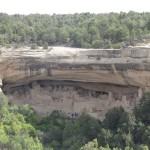Our travels have brought us to Mesa Verde, one of the truly extraordinary landscapes of the United States. Indeed, it is more than a piece of North American geography and history; it is a World Heritage Site. Our guide explained the World Heritage designation comes not from Mesa Verde’s past, but from the fact that it is a living environment with an on-going history embodied in the Pueblo people who still live around the site and continue a language, art, and tradition that spans at least 1300 years of recorded history.
As I listened to the guide take us through the development of this continuous culture: from a nomadic hunter-gatherer society, to traders with a vast network of exchange stretching west to the Pacific ocean and as far south as Mexico, to farmers and artisans and architects, through a period when the cliff dwellings were abandoned for some unknown reason, and on to the present day, I mused about the fact that every single person alive today has a continuous lineage stretching back to the dawn of creation. We may not know our culture the way some of the Pueblo people know theirs, but our family tree is very deeply rooted and very broad of branch and leaf.
What many religions tell us in myth and scripture is assuredly true: humanity is one people. We are all related. All of us. Every single one.
As a Christian, I actually prefer that truth to the (fairly recent) idea that the universe was created 6,000 years ago and populated by fully developed homo sapiens. Maybe it is my “liberal” seminary training, but I’ve never found the Bible a particularly useful text when it comes to counting generations and extrapolating to the moment of creation. It seems pretty clear that those who wrote scripture did not have accurate dating of cosmic events as a primary goal; they were trying to communicate something radically other and infinitely more important. Something about right relationship and what makes life abundant and rich.
I mused about the fact that the ancestors of those alive today have withstood the Ice Age, war, plague, volcanoes, shipwreck, childbirth, starvation, genocide, 30 year droughts, floods, food poisoning, snakebite, boned corsets, tie-dye, and (literally) everything else the world can throw at us…and we did it as clusters of people, as communities, as societies and cultures. We did not do it as individuals. Individuals, after all, cannot procreate; it takes a community of two. If our ancestors had insisted on remaining purely individuals with the fierce idiocy some of us bring to that desire today, we would have lasted exactly one generation.
So, naturally, I began to muse about what we have learned in all these generations of relying on one another to make it through childbirth and drought and forest fire and tsunami. For instance, if we look closely at the evidence, it is clear that we thrive only when we were willing to share our knowledge with other communities and to learn from their wisdom. It was some small tribe that settled far, far south of Mesa Verde that discovered corn – which in its original state is a small grass only ankle high with a head the size of my first finger, yet this is the corn that was cultivated on the mesa tops. Someone discovered it was good to eat and someone else traded it for…for what? a pot, a basket, a rabbit pelt? Someone traded enough seeds so that a crop could grow that first year and could be stored and a larger crop grown the second year, and that trade of corn seeds for pottery or rabbit pelts allowed the people of Mesa Verde (and, presumably, the people with whom they traded) to thrive.
We all know this truth about thriving; it is written in our genetic code. I wonder when we are going to pay attention to it. I wonder when we are going to look around and see – really see – that we are sisters and brothers (literally sisters and brothers, tracing our families back to the same warm pool of single-celled organisms) regardless of skin color, eye color, height, strength, intelligence, gifts or wounds. We know that abundance comes not from hoarding, but from sharing ideas, visions, dreams, skills, and mistakes. We would have no culture, no science, no art, no language if we were not many and diverse…and willing to give what we know and who we are to the wider world.
When are we going to pay attention? When will we lean into our confidence in that truth and be willing to live it whether our neighbor does or not?
Mesa Verde is magnificent, exquisitely beautiful, mysterious and awe-inspiring. It is a testament to people who knew farming and hunting, pottery making, medicine, architecture, astronomy, and who could travel thousands of miles to trade with strangers. But is it enough to admire those who abandoned these cliff dwellings more than 600 years ago — and who are, of course, safely dead and who need nothing from me? Or do I have a responsibility to care for the living Pueblo who have been stripped of their ancestral lands and as much of their language, religion and culture as the dominant European immigrants were able to claim and erase? Do I have a responsibility to care for (which is not the same as “take care of”) my sisters and brothers and cousins, trading knowledge for different knowledge, wisdom for different wisdom, craft skill for different craft skill? being a true companion of the real people alive today?
Teilhard de Chardin said it this way, “Someday, after mastering the winds, the waves, the tides and gravity, we shall harness for God the energies of love, and then, for a second time in the history of the world, humanity will have discovered fire.”
Isn’t someday now? Right now? Today?
–Andrea
Text © 2014, Andrea La Sonde Anastos
Photo © 2014, Immram Chara, LLC
